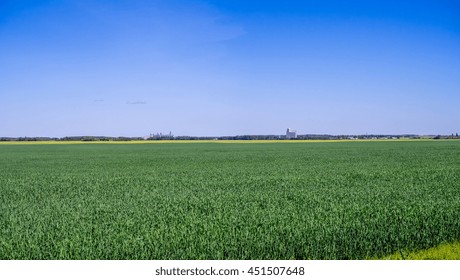About Saskatchewan
Stepping into the expansive lands of Saskatchewan, one is immediately met with a harmonious blend of rolling prairies, dense forests, and tranquil lakes. This province is situated right in the heart of Canada and remains one of the country’s most intriguing and least understood regions.
At first glance, the vastness of its landscape might suggest emptiness, but delving deeper, the diversity and richness of its ecosystem, history, and culture become unmistakably evident.
The population of Saskatchewan, as with many Canadian provinces, has seen its ups and downs. Yet, the numbers only tell half the story. Behind each statistic lies a tale of indigenous communities with histories dating back thousands of years, settlers who arrived with dreams of a better life, and modern urbanites who have chosen Saskatchewan as their home. Together, they have woven a rich tapestry that speaks to the spirit of resilience, diversity, and innovation.
One cannot discuss Saskatchewan without highlighting its significance as an agricultural powerhouse. The vast and fertile plains have given rise to a thriving agricultural sector, making the province a key player in global food production. Wheat, barley, and canola are just a few of the many crops that flourish here. But agriculture isn’t the only card in its deck; the province is also endowed with abundant natural resources like potash, uranium, and oil.
As you traverse the vastness of Saskatchewan, from the bustling urban center of Saskatoon to the quiet charm of places like Moose Jaw or Prince Albert, it becomes evident that this is a province of contrasts. Modern infrastructure nestles beside untouched natural beauty. Dynamic cultural festivals burst forth in the midst of serene landscapes.
But perhaps what stands out the most about Saskatchewan is its community spirit. There’s a shared sense of pride among its residents, a collective understanding of the province’s uniqueness and the role it plays in the larger Canadian narrative.
In conclusion, Saskatchewan is more than just a geographical entity or a data point on Canada’s population chart. It’s a vivid tapestry of stories, traditions, and landscapes. A province where the past meets the present, where nature meets civilization, and where every individual, irrespective of their background, contributes to its vibrant mosaic.
Population Characteristics
According to the latest census, Saskatchewan has a population of around 1,132,505 people. The province's population is in increased . Between 2016 and 2021, the population of Newfoundland and Labrador has increased by 3.11%.
| Population in 2016 | Population in 2021 | Difference |
|---|---|---|
| 1,098,352 | 1,132,505 | +3.11% |
Population By Genders
The male population of Saskatchewan is around 563,120 while the female population is around 569,385.
Of the 1,132,505 total population in Saskatchewan, the largest gender is female with around 569,385 women within the population.
| Male | Female | Difference |
|---|---|---|
| 563,120 | 569,385 | +1.10% |
Population by Age Characteristics
Saskatchewan has a young population. The majority of the population is people aged 35 to 39 years old, accounting for 7.00% of the total population. The province median age is 38.80.
| Data | Male | Female | Difference | Total |
|---|---|---|---|---|
| 35 to 39 years | 39,380 7.00% | 40,040 7.00% | 1.65% | 79,420 7.00% |
| 30 to 34 years | 38,930 6.90% | 39,450 6.90% | 1.32% | 78,380 6.90% |
| 10 to 14 years | 39,600 7.00% | 37,520 6.60% | 5.25% | 77,120 6.80% |
| 5 to 9 years | 39,210 7.00% | 37,340 6.60% | 4.77% | 76,545 6.80% |
| 60 to 64 years | 36,725 6.50% | 37,430 6.60% | 1.88% | 74,155 6.50% |
| 55 to 59 years | 36,045 6.40% | 37,120 6.50% | 2.90% | 73,165 6.50% |
| 40 to 44 years | 36,670 6.50% | 36,380 6.40% | 0.79% | 73,055 6.50% |
| 25 to 29 years | 35,420 6.30% | 34,605 6.10% | 2.30% | 70,030 6.20% |
| 0 to 4 years | 35,555 6.30% | 33,900 6.00% | 4.65% | 69,455 6.10% |
| 15 to 19 years | 35,525 6.30% | 32,985 5.80% | 7.15% | 68,510 6.00% |
| 20 to 24 years | 34,580 6.10% | 32,295 5.70% | 6.61% | 66,870 5.90% |
| 45 to 49 years | 32,425 5.80% | 32,655 5.70% | 0.70% | 65,075 5.70% |
| 65 to 69 years | 32,140 5.70% | 32,630 5.70% | 1.50% | 64,770 5.70% |
| 50 to 54 years | 31,300 5.60% | 31,440 5.50% | 0.45% | 62,745 5.50% |
| 70 to 74 years | 23,790 4.20% | 25,160 4.40% | 5.45% | 48,945 4.30% |
| 75 to 79 years | 15,605 2.80% | 17,445 3.10% | 10.55% | 33,045 2.90% |
| 85 years and over | 9,945 1.80% | 17,820 3.10% | 44.19% | 27,765 2.50% |
| 80 to 84 years | 10,290 1.80% | 13,170 2.30% | 21.87% | 23,460 2.10% |
| 85 to 89 years | 6,290 1.10% | 9,870 1.70% | 36.27% | 16,165 1.40% |
| 90 to 94 years | 2,965 0.50% | 5,750 1.00% | 48.43% | 8,715 0.80% |
| 95 to 99 years | 625 0.10% | 1,810 0.30% | 65.47% | 2,435 0.20% |
| 100 years and over | 60 0.00% | 385 0.10% | 84.42% | 450 0.00% |
Broader Age Groups
If the province's population is divided into broader age groups, most of the population falls into the 15 to 64 years age group. The group accounts for 62.80% of the population. The other age groups, 0 to 14 years and 65 years and over, account for 19.70% and 17.50%, respectively.
If we look at the population data from the broader age groups, we can see that most people in Saskatchewan are within the 15 to 64 years age group.
| Data | Male | Female | Total |
|---|---|---|---|
| 15 to 64 years | 63.40% | 62.20% | 62.80% |
| Average age of the population | 38.90% | 40.70% | 39.80% |
| Median age of the population | 38.00% | 39.60% | 38.80% |
| 0 to 14 years | 20.30% | 19.10% | 19.70% |
| 65 years and over | 16.30% | 18.70% | 17.50% |
Population of Saskatchewan by Ethnicity and Origin
The population of Saskatchewan is quite diverse, which contributes to the province's vibrant cultural landscape. Saskatchewan is inclusive and accepts various ethnic groups with open arms. Furthermore, the province appreciates the unique contributions that each ethnicity brings.
The top 5 ethnicities and origins in the province are German, which accounts for 24.70% of the total population, followed by English (19.91%), Scottish (15.92%), Irish (13.18%), and Ukrainian (12.57%).
Other ethnicities and origins in Newfoundland and Labrador include French, Canadian, Norwegian, Polish, and First Nations (North American Indian).
| Ethnicity and Origin | Male | Female | Percentage in Population |
|---|---|---|---|
| German | 24.40% | 25.00% | 24.70% |
| English | 19.52% | 20.30% | 19.91% |
| Scottish | 15.58% | 16.25% | 15.92% |
| Irish | 12.65% | 13.71% | 13.18% |
| Ukrainian | 12.31% | 12.83% | 12.57% |
| French | 9.59% | 10.05% | 9.82% |
| Canadian | 10.00% | 9.41% | 9.71% |
| Norwegian | 6.17% | 6.55% | 6.36% |
| Polish | 4.88% | 5.20% | 5.04% |
| First Nations (North American Indian) | 4.48% | 4.72% | 4.60% |
Household and Dwelling Characteristics
About 322,070 of Saskatchewan's population live in a single-detached house. In addition, most of them are living in 2 persons household.
Household Size
About 17.65% of the population lives in 2 persons households. 1 person households ranked second, accounting for 14.45% of the population. 3 persons, 4 persons, and 5 or more persons households account for 6.70%, 6.45%, and 4.75%, respectively.
| Number of Person(s) in Household | Total | Percentage |
|---|---|---|
| 2 persons | 158,555 | 17.65% |
| 1 person | 130,110 | 14.45% |
| 3 persons | 60,185 | 6.70% |
| 4 persons | 57,860 | 6.45% |
| 5 or more persons | 42,875 | 4.75% |
Income in Saskatchewan
Analyzing income distribution in Saskatchewan can help us better understand its socioeconomic dynamics.
Per Capita Income
According to 2020 data, the median personal income within Saskatchewan is $42,400.
A region's per capita data sheds light on the average income earned per person living in it. Since per capita income is calculated by dividing the region's total income by its population, it quantifies the population's economic situation on an individual basis.
Such data offers insights into the province's economic performance, spread of income across individuals, quality of life, as well as disparities within its borders.
Most of Saskatchewan population or around 591,660 people falls in the $10,000 to $29,999 group. The next largest groups are the $30,000 to $49,999, and $50,000 to $79,999 with around 551,325 and 513,315 people, respectively.
Household Income
The Saskatchewan's median household income is $82,000, according to 2020 data.
The data provides important insights into the province's economic landscape as well as the living standards of its population.
Analyzing such data enables researchers, policymakers, and businesses to gain a more comprehensive understanding of the province's income distribution, disparities, and trends.
Education Levels in Saskatchewan
This data sheds light on the distribution of Saskatchewan residents across educational milestones.
Such information is crucial in shaping the province’s policies on education, workforce development strategies, and initiatives that aim to improve access to quality education and promote lifelong learning opportunities.
54.30% or most of the Saskatchewan population has a Postsecondary certificate, diploma or degree. 31.25% of the population has a High (secondary) school diploma or equivalency certificate, 23.15% has a Bachelor's degree or higher, and 14.45% has No certificate, diploma or degree.
| Degree | Men | Women | Total | Percentage |
|---|---|---|---|---|
| Postsecondary certificate, diploma or degree | 353,545 | 418,730 | 772,270 | 54.30% |
| High (secondary) school diploma or equivalency certificate | 237,440 | 218,470 | 455,910 | 31.25% |
| Bachelor's degree or higher | 138,025 | 189,390 | 327,415 | 23.15% |
| No certificate, diploma or degree | 126,900 | 94,295 | 221,195 | 14.45% |
Employment in Saskatchewan
This dataset provides a snapshot of employment trends in Saskatchewan. It encompasses a wide range of sectors, industries, as well as job categories.
The data shows that the unemployment rate in Newfoundland and Labrador is at 5.51% which is quite high.
| Status | Percentage |
|---|---|
| Employment rate | 59.91% |
| Unemployment rate | 5.51% |
Working as an Employee
The table shows the data on the total number of individuals in the province who work as an employee. The majority of Saskatchewan's population (around 66.50%) are working permanent position as an employee.
Self-employed
In the province, there are 59,430 men and 34,225 women working as self-employed individuals, bringing the total number to 93,655.
| Status | Men | Women | Total |
|---|---|---|---|
| Self-employed | 59,430 | 34,225 | 93,655 |
Employment Industry Sectors
The Saskatchewan industry employment sector census data offers insights into the region's economic landscape. The distribution of employment in Saskatchewan is categorized and quantified, which reveals the region's economic composition.
Saskatchewan has a wide range of industries. Most of its population (14%) works in the health care and social assistance sector. The Retail trade sector comes second at 11%, followed by Agriculture, forestry, fishing and hunting at 8%.
| Industry | Men | Women | Percentage |
|---|---|---|---|
| Health care and social assistance | 14,190 | 66,270 | 14% |
| Retail trade | 30,005 | 31,475 | 11% |
| Agriculture, forestry, fishing and hunting | 34,620 | 14,130 | 8% |
| Educational services | 13,905 | 32,305 | 8% |
| Construction | 38,640 | 5,490 | 8% |
| Public administration | 19,420 | 19,795 | 7% |
| Accommodation and food services | 14,110 | 18,595 | 6% |
| Professional, scientific and technical services | 13,725 | 12,945 | 5% |
| Manufacturing | 20,290 | 5,910 | 5% |
| Other services (except public administration) | 12,800 | 13,025 | 5% |
| Transportation and warehousing | 19,320 | 4,910 | 4% |
| Wholesale trade | 14,675 | 5,135 | 3% |
| Finance and insurance | 6,845 | 12,750 | 3% |
| Mining, quarrying, and oil and gas extraction | 16,035 | 2,515 | 3% |
| Administrative and support, waste management and remediation services | 10,140 | 7,405 | 3% |
| Arts, entertainment and recreation | 5,090 | 5,060 | 2% |
| Information and cultural industries | 4,180 | 3,950 | 1% |
| Real estate and rental and leasing | 3,950 | 3,240 | 1% |
| Utilities | 4,320 | 1,530 | 1% |
| Management of companies and enterprises | 350 | 440 | 0% |
Places of Work
The data offers insights into the commuting patterns as well as workplace distribution in the province. It provides a snapshot of workplaces, showing their geographic distribution and the flow of workers across different areas.
| Work Location | Men | Women | Total | Percentage |
|---|---|---|---|---|
| Usual place of work | 172,210 | 187,320 | 359,530 | 68.00% |
| Worked at home | 49,585 | 47,940 | 97,525 | 18.40% |
| No fixed workplace address | 54,970 | 16,125 | 71,095 | 13.40% |
| Worked outside Canada | 515 | 235 | 755 | 0.10% |
Commuting
The data sheds light on how Saskatchewan residents travel to school or work. It highlights the frequency of different modes of transportation like walking, cycling, carpooling, and public transit.
The data is pivotal in the making of transportation policies as well as the development of transit systems. Ultimately commuting data contributes to improving the quality of life of Saskatchewan residents and sustainable urban planning.
Commuting Duration
This data reveals the average time that the residents of Saskatchewan spend traveling to their workplaces. It also sheds light on the efficiency of the province's public transit systems, and road networks, as well as the accessibility of the province.
| Duration | Percentage |
|---|---|
| Less than 15 minutes | 47.10% |
| 15 to 29 minutes | 35.30% |
| 30 to 44 minutes | 9.90% |
| 60 minutes and over | 4.20% |
| 45 to 59 minutes | 3.40% |
Marital Status
The statistics on marital status in Saskatchewanshed light on its societal dynamics. It captures the diverse types of marital statuses of the population.
Long-term commitments, such as common-law partnerships, civil unions, and marriages, reflect the province's social fabric. We can gain insights into Saskatchewan's changing preferences and norms by examining the trends in marital status.
Language Spoken
The data below highlights province's linguistic diversity, showing elegances of solo language as well as bilingual harmonies. Other than language, it also shows the cultural landscape in Canada.
English is the most spoken official language in Saskatchewan. About 1,094,690 people living in the province speak English, 11,335 people speak French, 8,200 people speak Neither English nor French language, and 1,815 people speak English and French language.
| Language | Population |
|---|---|
| English | 1,094,690 |
| French | 11,335 |
| Neither English nor French | 8,200 |
| English and French | 1,815 |
Religion
Saskatchewan is predominantly Christian. About 621,250 of its population is Christian (294,000 males and 294,000 females).
The second largest religion in the province is Muslim with 2.3% of the population adhering to the religion. There are also Hindu and Sikh, both represent 1.3% and 0.8% of the population, while Buddhist represent 0.4% of the population.
| Religion | Population |
|---|---|
| Christian | 56.3% |
| Islam | 2.3% |
| Hindu | 1.3% |
| Sikh | 0.8% |
| Buddhist | 0.4% |
| Jewish | 0.1% |
Cities in Saskatchewan
- Estevan
- Humboldt
- Lloydminster [Part]
- Martensville
- Meadow Lake
- Melfort
- Melville
- Moose Jaw
- North Battleford
- Prince Albert
- Regina
- Saskatoon
- Star City No. 428
- Swift Current
- Warman
- Weyburn
- Yorkton
Towns in Saskatchewan
- Aberdeen
- Alameda
- Allan
- Arborfield
- Arcola
- Asquith
- Assiniboia
- Balcarres
- Balgonie
- Battleford
- Bengough
- Bienfait
- Big River
- Biggar
- Birch Hills
- Blaine Lake
- Bredenbury
- Broadview
- Bruno
- Burstall
- Cabri
- Canora
- Carlyle
- Carnduff
- Carrot River
- Central Butte
- Choiceland
- Churchbridge
- Colonsay
- Coronach
- Craik
- Creighton
- Cudworth
- Cupar
- Cut Knife
- Dalmeny
- Davidson
- Delisle
- Duck Lake
- Dundurn
- Eastend
- Eatonia
- Elrose
- Eston
- Fleming
- Foam Lake
- Fort Qu’Appelle
- Francis
- Govan
- Grand Coulee
- Gravelbourg
- Grenfell
- Gull Lake
- Hafford
- Hague
- Hanley
- Hepburn
- Herbert
- Hudson Bay
- Imperial
- Indian Head
- Ituna
- Kamsack
- Kelvington
- Kerrobert
- Kindersley
- Kinistino
- Kyle
- La Ronge
- Lafleche
- Lampman
- Langenburg
- Langham
- Lanigan
- Lashburn
- Leader
- Lemberg
- Leroy
- Luseland
- Macklin
- Maidstone
- Maple Creek
- Marshall
- Midale
- Milestone
- Moosomin
- Morse
- Mossbank
- Naicam
- Nipawin
- Nokomis
- Norquay
- Ogema
- Osler
- Outlook
- Oxbow
- Pense
- Pilot Butte
- Ponteix
- Porcupine Plain
- Preeceville
- Qu’Appelle
- Radisson
- Radville
- Raymore
- Redvers
- Regina Beach
- Rocanville
- Rockglen
- Rose Valley
- Rosetown
- Rosthern
- Rouleau
- Saltcoats
- Scott
- Shaunavon
- Shellbrook
- Sintaluta
- Southey
- Spiritwood
- Springside
- St. Brieux
- St. Walburg
- Star City
- Stoughton
- Strasbourg
- Sturgis
- Tisdale
- Turtleford
- Unity
- Vonda
- Wadena
- Wakaw
- Waldheim
- Wapella
- Watrous
- Watson
- Wawota
- White City
- Whitewood
- Wilkie
- Willow Bunch
Villages in Saskatchewan
- Abbey
- Abernethy
- Albertville
- Alida
- Alvena
- Annaheim
- Archerwill
- Arran
- Atwater
- Avonlea
- Aylesbury
- Aylsham
- Bangor
- Beatty
- Beechy
- Belle Plaine
- Bethune
- Bjorkdale
- Bladworth
- Borden
- Bracken
- Bradwell
- Briercrest
- Broderick
- Brownlee
- Buchanan
- Buena Vista
- Bulyea
- Cadillac
- Calder
- Canwood
- Carievale
- Caronport
- Ceylon
- Chaplin
- Christopher Lake
- Clavet
- Climax
- Coderre
- Codette
- Coleville
- Conquest
- Consul
- Craven
- Creelman
- Debden
- Denholm
- Denzil
- Dilke
- Dinsmore
- Disley
- Dodsland
- Dorintosh
- Drake
- Drinkwater
- Dubuc
- Duff
- Duval
- Dysart
- Earl Grey
- Ebenezer
- Edam
- Edenwold
- Elbow
- Elfros
- Endeavour
- Englefeld
- Ernfold
- Eyebrow
- Fairlight
- Fenwood
- Fillmore
- Findlater
- Flaxcombe
- Forget
- Fosston
- Fox Valley
- Frobisher
- Frontier
- Gainsborough
- Gerald
- Glaslyn
- Glen Ewen
- Glenavon
- Glenside
- Golden Prairie
- Goodeve
- Goodsoil
- Goodwater
- Grayson
- Halbrite
- Hawarden
- Hazenmore
- Hazlet
- Heward
- Hodgeville
- Holdfast
- Hubbard
- Hyas
- Invermay
- Jansen
- Kelliher
- Kenaston
- Kendal
- Kennedy
- Kenosee Lake
- Killaly
- Kincaid
- Kinley
- Kisbey
- Krydor
- Lake Lenore
- Lancer
- Landis
- Lang
- Leask
- Lebret
- Leoville
- Leross
- Liberty
- Lintlaw
- Lipton
- Loon Lake
- Loreburn
- Love
- Lucky Lake
- MacNutt
- Macoun
- Macrorie
- Major
- Makwa
- Mankota
- Manor
- Marcelin
- Marengo
- Margo
- Markinch
- Marquis
- Marsden
- Maryfield
- Maymont
- McLean
- McTaggart
- Meacham
- Meath Park
- Medstead
- Mendham
- Meota
- Mervin
- Michel Village
- Middle Lake
- Milden
- Minton
- Mistatim
- Montmartre
- Mortlach
- Muenster
- Neilburg
- Netherhill
- Neudorf
- Neville
- North Portal
- Odessa
- Osage
- Paddockwood
- Pangman
- Paradise Hill
- Parkside
- Paynton
- Pelly
- Pennant
- Perdue
- Pierceland
- Pilger
- Pleasantdale
- Plenty
- Plunkett
- Prelate
- Primate
- Prud’homme
- Punnichy
- Quill Lake
- Quinton
- Rama
- Rhein
- Richard
- Richmound
- Ridgedale
- Riverhurst
- Roche Percee
- Ruddell
- Rush Lake
- Sceptre
- Sedley
- Semans
- Senlac
- Shamrock
- Sheho
- Shell Lake
- Silton
- Simpson
- Smeaton
- Smiley
- Spalding
- Speers
- Spy Hill
- St. Benedict
- St. Gregor
- St. Louis
- Stenen
- Stewart Valley
- Stockholm
- Storthoaks
- Strongfield
- Success
- Tantallon
- Tessier
- Theodore
- Togo
- Tompkins
- Torquay
- Tramping Lake
- Tribune
- Tugaske
- Tuxford
- Val Marie
- Valparaiso
- Vanguard
- Vanscoy
- Vibank
- Viscount
- Waldeck
- Waldron
- Waseca
- Webb
- Weekes
- Weirdale
- Weldon
- White Fox
- Wilcox
- Windthorst





